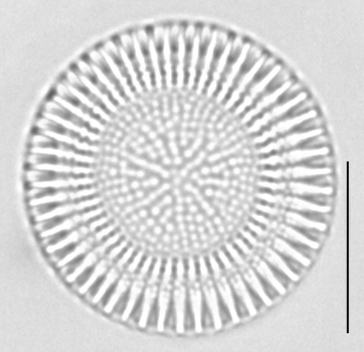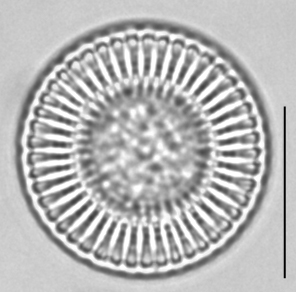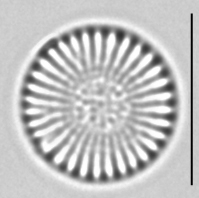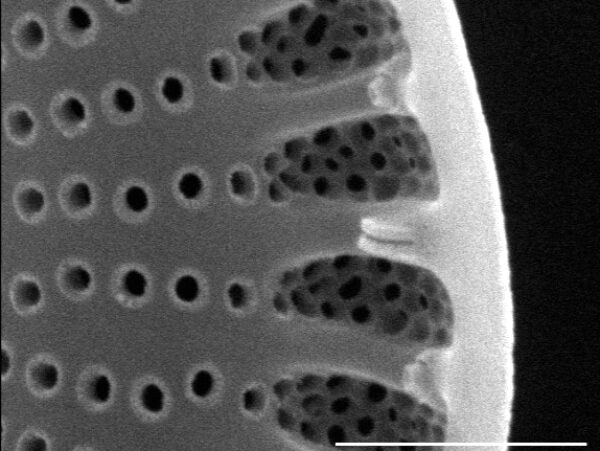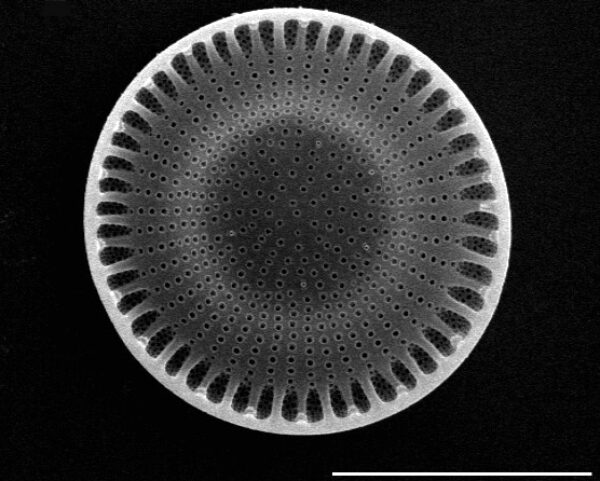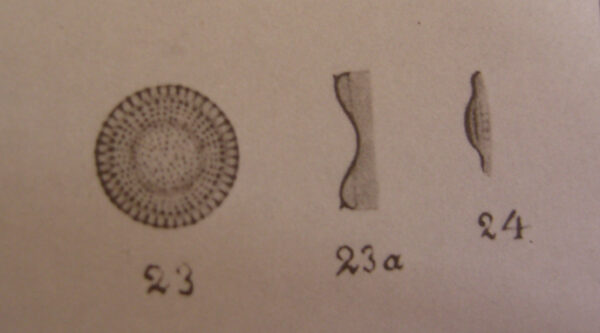Cyclostephanos dubius
-
Category
-
Diameter8.6-18.5 µm
-
SynonymsStephanodiscus dubius (Fricke) Hust. 1930
-
ContributorLena Ivarsson - Jun 2011
-
ReviewerMark Edlund - Mar 2014
Identification
Description
Valves are centric, with distinct costae. The valves are strongly concentrically undulate and show complementarity, with the central area of the valve face being either concave or convex. Characteristic chambers, called alveolae, are present near the valve margin. In large specimens, the central areolae are often organized into radial striae. In small specimens, the central areolae appear to be scattered randomly. A single rimoportula is located on the mantle, on an extension of a costa. Several central fultoportulae are positioned on the valve face, forming an irregular ring. Fultoportulae are also present on the mantle, on an extension of every second to third costa. Costae number 9-12 in 10 µm.
Based on European (West Germany, Poland, and Sweden) specimens, Håkansson and Hickel (1987) distinguished two morphotypes of Cyclostephanos dubius. Morphotype 1 was distinguished by more heavily silicified specimens, with coarse structure. The diameter of the valves was reported as 4.9-22.5 µm, with 9-12 costae in 10 µm. Morphotype 2 was distinguished as more weakly silicified, with finer structure. Morphotype 2 diameter ranged between 11.2–35.0 µm, with 12-18 costae in 10 µm. A central rosette, or annulus, is present in most morphotype 2 specimens. The morphotypes also differ in the length of the costae. Morphotype 1 has costae 1.25 µm in length, while morphotype 2 has slightly shorter costae, 1.0-1.25 µm in length. This feature, however, is only visible in SEM. The fultoportulae of morphotype 2 are arranged in an irregular ring near the center of the valve face and visible in LM. This feature however is not visible for morphotype 1. The material examined from West Okoboji Lake consisted only of specimens conforming to morphotype 1. Hickel and Håkansson (1987) also describe the occasional presence of spines in both morphotypes, with no spines, to spines on every second to sixth costa, to spines on every costa. No spines were been observed in specimens from North America.
Note that Round's (1982) description of the genus Cyclostephanos was invalid. Consequently, all of the taxa transferred to Cyclostephanos at that time were also invalid. In Theriot et al. (1987), the genus was validated the name Cyclostephanos dubius was also published.
Autecology
Cyclostephanos dubius was found in great abundance in a plankton net sample from Beck’s Canal, West Lake Okoboji, Dickinson County, Iowa. Beck's Canal is a shallow set of channels connecting wetlands and residential areas and has a heavily exploited shoreline. The surrounding area mostly consists of agricultural land. The sample was collected 25 May 2011, water temperature was 19.2°C, conductivity measured 430 µS/cm, dissolved oxygen was 6.4 mg/L and the pH was 7.3.
Several studies of C. dubius have been done in Europe (Hickel and Håkansson 1987, Casper and Scheffler 1987, Anderson 1990, Bradshaw and Anderson 2003), but C. dubius has been less frequently reported from North America (Theriot and Stoermer 1982).
Cyclostephanos dubius is considered to be a halophilic species of both fresh and brackish lakes. In Sweden, C. dubius has been found in high abundance in eutrophic lakes with high conductivity (Hickel and Håkansson, 1987). High abundance of small centric, planktonic diatoms is often used as an eutrophication indicator (Anderson 1990).
-
Size Range, µm3
-
Motility
-
Attachment
-
Habitat
-
Colony
-
BCG
-
Waterbody
-
Distribution
- Learn more about this
Citations & Links
Citations
-
Publication Link: 10.1080/0269249X.1987.9704983
Links
-
Index Nominum Algarum
-
GenBank
-
North American Diatom Ecological DatabaseNADED ID: 19000
Cite This Page
Ivarsson, L. (2011). Cyclostephanos dubius. In Diatoms of North America. Retrieved April 18, 2024, from https://diatoms.org/species/cyclostephanos_dubius
Responses
The 15 response plots show an environmental variable (x axis) against the relative abundance (y axis) of Cyclostephanos dubius from all the stream reaches where it was present. Note that the relative abundance scale is the same on each plot. Explanation of each environmental variable and units are as follows:
ELEVATION = stream reach elevation (meters)
STRAHLER = distribution plot of the Strahler Stream Order
SLOPE = stream reach gradient (degrees)
W1_HALL = an index that is a measure of streamside (riparian) human activity that ranges from 0 - 10, with a value of 0 indicating of minimal disturbance to a value of 10 indicating severe disturbance.
PHSTVL = pH measured in a sealed syringe sample (pH units)
log_COND = log concentration of specific conductivity (µS/cm)
log_PTL = log concentration of total phosphorus (µg/L)
log_NO3 = log concentration of nitrate (µeq/L)
log_DOC = log concentration of dissolved organic carbon (mg/L)
log_SIO2 = log concentration of silicon (mg/L)
log_NA = log concentration of sodium (µeq/L)
log_HCO3 = log concentration of the bicarbonate ion (µeq/L)
EMBED = percent of the stream substrate that is embedded by sand and fine sediment
log_TURBIDITY = log of turbidity, a measure of cloudiness of water, in nephelometric turbidity units (NTU).
DISTOT = an index of total human disturbance in the watershed that ranges from 1 - 100, with a value of 0 indicating of minimal disturbance to a value of 100 indicating severe disturbance.
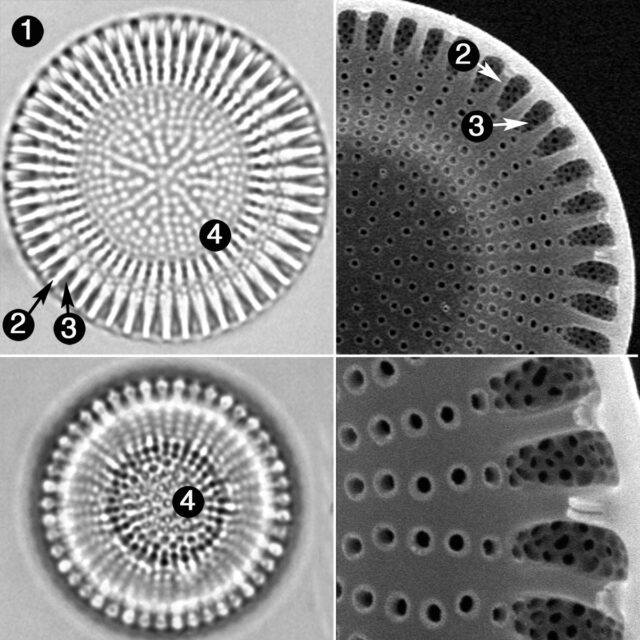
Cyclostephanos dubius
- Valve concentrically undulate
- Marginal costae distinct
- Alveolae distinct
- Central areolae organized or scattered
Valves are strongly concentrically undulate. Marginal costae alternate with marginal chambers, called alveolae. The central areolae of large specimens are often organized into striae, while the central areolae of smaller specimens are more irregular and scattered. Spines are absent.
 Diatoms of North America
Diatoms of North America